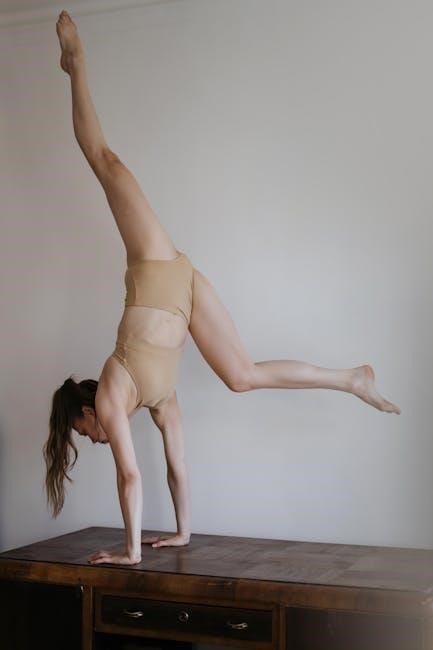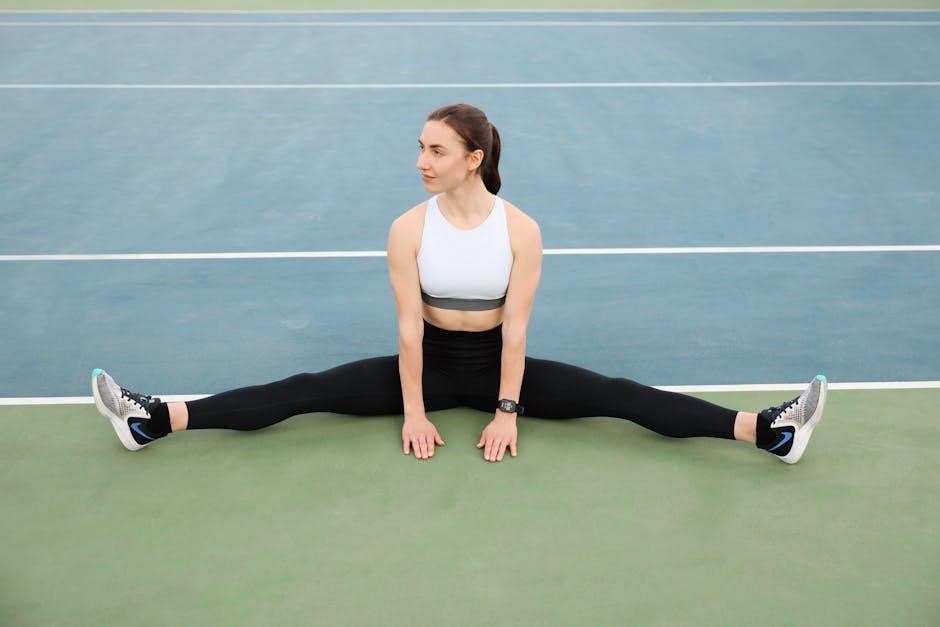Cervical stabilization exercises are essential for improving neck strength and stability, reducing pain, and enhancing posture․ They target deep cervical muscles and are often recommended in physical therapy for chronic neck conditions․
1․1 Overview of Cervical Spine and Its Importance
The cervical spine, located in the neck, consists of seven vertebrae and supports the head’s weight while enabling flexible movement․ It houses the spinal cord, which is crucial for transmitting nerve signals between the brain and body․ Proper cervical spine alignment is vital for maintaining posture, preventing pain, and ensuring the protection of delicate neural structures․ Weakness or instability in this region can lead to chronic pain, limited mobility, and functional impairments, emphasizing the need for targeted stabilization exercises to enhance strength and stability․
1․2 Purpose of Cervical Stabilization Exercises
Cervical stabilization exercises aim to enhance neck strength, improve spinal stability, and reduce pain․ These exercises target the deep cervical muscles, improving posture and reducing strain on the cervical spine․ By strengthening the muscles around the neck, they help alleviate discomfort, prevent injury, and promote proper cervical alignment; Regular practice can also improve range of motion and reduce the risk of chronic neck conditions, making them a cornerstone of physical therapy for cervical health and overall well-being․

Understanding Proper Posture
Proper posture involves maintaining a neutral cervical spine alignment, with shoulders relaxed and ears in line with shoulders․ It promotes muscle balance, reduces strain, and prevents pain․
2․1 Neutral Cervical Spine Alignment
A neutral cervical spine alignment maintains the natural curve of the neck, with ears aligned above shoulders and chin level․ This posture minimizes strain on muscles and joints, promoting comfort and stability․ It is crucial for preventing long-term neck issues and enhancing the effectiveness of cervical stabilization exercises․ Achieving this alignment requires awareness and practice, often guided by physical therapy or ergonomic adjustments․
2․2 Common Postural Mistakes and Their Impact
Prolonged poor posture, such as a “poking chin” or slouched position, strains cervical muscles and joints․ This often results from low desk height, high screen placement, or habitual slouching․ Over time, these mistakes can lead to muscle imbalances, stiffness, and chronic neck pain․ They also reduce the effectiveness of cervical stabilization exercises, making it harder to achieve long-term neck health․ Addressing these postural errors is crucial for preventing further discomfort and promoting optimal spinal alignment․

Basic Cervical Stabilization Exercises
Cervical stabilization exercises improve neck strength and stability․ Common examples include chin tucks and cervical retractions, enhancing posture and reducing muscle strain effectively․
3․1 Chin Tucks (Chin Glide)
Chin tucks, or chin glides, are foundational exercises for cervical stabilization․ Sit or stand with good posture, keeping your eyes and chin level․ Gently pull your head back as if being pulled by a string from the top, creating a double chin; Hold for 5-10 seconds, then release․ Repeat 10-15 times, 2-3 sets daily․ This exercise strengthens the deep cervical muscles, improving neck stability and reducing forward head posture․ It’s simple, effective, and requires no equipment, making it ideal for daily practice to enhance cervical strength and alignment․
3․2 Cervical Retraction
Cervical retraction strengthens the neck muscles and improves posture․ Stand with feet shoulder-width apart, place hands behind your head, and gently resist as you perform a chin tuck․ Hold for 3 seconds, release, and repeat 10-15 times․ This exercise targets the cervical flexors and retractors, enhancing neck stability and reducing forward head posture․ Perform 2-3 sets, 3-5 times weekly․ It’s effective for relieving tension and improving cervical alignment, making it a key component of neck stabilization routines․
3․3 Gentle Neck Tilts and Rotations
Gentle neck tilts and rotations are essential for improving cervical flexibility and range of motion․ Sit or stand with good posture, then slowly tilt your head to the side, bringing your ear toward your shoulder․ Hold for 5-10 seconds and repeat on the opposite side․ For rotations, turn your head to one side until a stretch is felt, holding for 5-10 seconds․ Perform 5-10 repetitions for each movement․ These exercises enhance neck mobility and reduce stiffness, making them ideal for daily routines to maintain cervical health and prevent strain․

Strengthening Exercises for the Neck
Strengthening exercises for the neck target cervical muscles to improve stability and endurance․ Examples include cervical isometrics, resistance band exercises, and scapular stabilization to enhance overall neck health․
4․1 Cervical Isometrics
Cervical isometrics involve resisting neck movements without moving the head․ To perform, stand or sit upright, place hands behind the head, and gently resist the movement while performing a chin tuck․ This exercise strengthens deep cervical muscles, improving stability and endurance․ Hold for 3-5 seconds, repeating 10-15 times for 2-3 sets․ Aim to do this 3-5 times weekly․ It’s essential to maintain proper posture and avoid using excessive force to prevent strain․ This exercise is effective for building foundational neck strength and enhancing overall cervical stability over time with consistent practice․
4․2 Resistance Band Exercises for Neck Strengthening
Resistance band exercises effectively strengthen neck muscles by providing controlled resistance․ Anchor the band at forehead level and hold it securely․ Perform slow, controlled movements, such as tilting or rotating the head against the resistance․ Start with 10-15 repetitions per direction, gradually increasing as strength improves․ Maintain proper posture and avoid jerky movements to prevent strain․ These exercises enhance muscular endurance and stability, complementing other cervical stabilization techniques․ Consistency is key for achieving long-term neck health and reducing the risk of injury or discomfort․ Regular practice strengthens both flexor and extensor muscles, improving overall cervical function․
4․3 Scapular Stabilization Exercises
Scapular stabilization exercises strengthen shoulder muscles, improving posture and reducing neck strain․ Start with shoulder rolls and wall slides to enhance scapular mobility․ Perform exercises like planks and bird dogs to engage core and shoulder stabilizers․ Use resistance bands for exercises like lateral pull-aparts and rows․ Proper form and controlled movements are essential to prevent strain․ These exercises promote scapular stability, reducing neck pain and improving overall cervical health․ Consistent practice enhances posture and reduces the risk of injury, supporting long-term neck stability and function․

Stretching Exercises for the Neck and Shoulders
Stretching exercises relieve neck and shoulder tension, improving flexibility and posture․ Gentle stretches like the Levator Scapulae and Upper Trapezius stretches target tight muscles, promoting relaxation and mobility․ Perform tilts, rotations, and side bends to release stiffness․ Use a towel for deeper stretches if needed․ These exercises enhance blood flow, reduce muscle spasms, and improve range of motion, essential for long-term cervical health and comfort․
5․1 Levator Scapulae Stretch
The Levator Scapulae stretch targets the muscle connecting the neck and shoulder, often tight from poor posture․ Sit or stand with neutral spine․ Tilt head gently to the right, bringing ear toward right shoulder, until a stretch is felt on the left side․ Hold 20-30 seconds, breathing deeply․ Repeat 2-3 times on each side․ This stretch reduces tension, improves range of motion, and alleviates neck pain․ It’s a simple yet effective exercise for promoting cervical and shoulder relaxation․ Consistency enhances long-term flexibility and comfort․
5․2 Upper Trapezius Stretch
The Upper Trapezius Stretch targets the broad muscles of the upper back and neck․ Sit or stand with good posture․ Gently tilt your head to the right, bringing your ear toward your right shoulder, and use your right hand to apply light pressure․ Hold for 20-30 seconds, then repeat on the left side․ This stretch relieves tension, improves neck mobility, and reduces muscle strain․ Perform 2-3 repetitions on each side․ Regular practice helps maintain flexibility and prevents stiffness in the neck and shoulder region․
5․3 Scalene Muscle Stretch
The Scalene Muscle Stretch targets the muscles on the sides of the neck, improving flexibility and reducing tension․ Sit or stand with good posture․ Tilt your head gently to the right, bringing your ear toward your right shoulder, and use your right hand to apply light pressure․ Hold for 20-30 seconds, then repeat on the left side․ This stretch relieves tightness, enhances neck mobility, and reduces the risk of muscle strain․ Perform 2-3 repetitions on each side to maintain optimal neck and shoulder flexibility․

Pain Relief and Exercise
Gentle exercises and therapies can alleviate acute neck pain by improving flexibility and reducing muscle tension, promoting recovery without exacerbating discomfort or inflammation․
6․1 Gentle Exercises for Acute Neck Pain
For acute neck pain, gentle exercises like chin tucks and cervical retractions are beneficial․ These movements improve posture and reduce strain without worsening discomfort․ Chin tucks involve retracting the chin while keeping the head level, holding for a few seconds․ Cervical retractions strengthen neck muscles by resisting manual or band resistance․ Isometric exercises can also help stabilize the cervical spine, enhancing strength and flexibility․ These exercises are typically performed in a neutral position, either sitting or standing, and are repeated 10-15 times, 2-3 sets daily, to promote recovery and alleviate stiffness․
6․2 Using Heat or Ice Therapy with Exercises
Heat or ice therapy can complement cervical stabilization exercises by reducing muscle tension and improving circulation․ Applying heat before exercises relaxes muscles, making stretching more effective․ Ice therapy after exercise reduces inflammation and muscle soreness, especially for acute injuries․ Combining these therapies with gentle exercises like chin tucks and cervical retractions enhances recovery․ Always wrap ice or heat packs in a cloth to avoid skin irritation and limit sessions to 15-20 minutes․ This integrated approach supports neck health and accelerates healing, making it easier to perform daily activities without discomfort․

Core Stability and Its Role in Cervical Health
Core stability strengthens abdominal and back muscles, enhancing posture and reducing cervical strain․ Stronger core muscles support the neck, promoting better alignment and reducing the risk of injury․
7․1 Plank Exercises for Core Strength
Plank exercises are highly effective for building core strength, which is crucial for cervical health․ Start in a forearm plank position, ensuring your body is straight and rigid․ Engage your abdominals to maintain stability․ Hold for 20-30 seconds, rest, and repeat for 2-3 sets․ For variation, incorporate side planks to target oblique muscles․ Proper form is essential to avoid strain․ Regular planking improves posture, reduces cervical strain, and enhances overall spinal stability, making it a cornerstone of cervical stabilization routines․
7․2 Bridging Exercises
Bridging exercises strengthen the core and improve spinal stability, benefiting cervical health․ Lie on your back with knees bent and feet flat․ Engage your abdominals, then lift your hips upward, squeezing your glutes at the top․ Hold for 2-3 seconds before lowering slowly․ Perform 10-12 repetitions for 2-3 sets․ Variations include single-leg bridges for added challenge․ Bridging enhances pelvic and core stability, reducing cervical strain by improving postural support․ Consistency in this exercise promotes long-term neck and spinal health․
Advanced Cervical Stabilization Techniques
Advanced techniques include neural mobilization and cervical traction to enhance cervical stability and strength, often incorporating manual resistance or resistance bands for progressive strengthening․
8․1 Neural Mobilization
Neural mobilization focuses on improving the mobility of nerves in the cervical region․ It involves gentle stretches and movements that reduce nerve tension and improve circulation․ This technique is particularly effective for addressing radiating pain or discomfort caused by nerve irritation․ By incorporating slow, controlled motions, neural mobilization enhances the nervous system’s ability to function optimally, promoting long-term cervical stability and reducing the risk of injury or strain․ Regular practice of these exercises can lead to significant improvements in neck flexibility and overall spinal health, making it a crucial component of advanced cervical stabilization routines․
8․2 Cervical Traction
Cervical traction involves applying gentle, sustained pressure to relieve pressure on the cervical spine․ It can be performed manually or with equipment, improving spinal alignment and reducing nerve compression․ This technique is often used to address herniated discs or degenerative conditions, promoting healing and pain relief․ Regular cervical traction can enhance posture, reduce muscle tension, and improve joint mobility, making it a valuable component of advanced cervical stabilization programs․ It is typically used in conjunction with other exercises for optimal results and long-term neck health․

Maintenance and Prevention
Maintenance involves consistent core and neck exercises, ergonomic adjustments, and proper posture to prevent neck strain and promote long-term cervical health․ Regular routines ensure stability and reduce injury risk․
9․1 Daily Routine for Long-Term Neck Health
A daily routine for long-term neck health should include gentle cervical stabilization exercises, such as chin tucks and cervical retractions, performed in the morning and evening․ These exercises, done 10-15 repetitions for 2-3 sets, strengthen deep cervical muscles and improve posture․ Incorporating core stability exercises, like planks or bridging, enhances overall spinal support․ Maintaining proper ergonomic practices during daily activities, such as adjusting desk height and monitor position, reduces strain on the neck; Consistency in this routine helps prevent future discomfort and promotes lasting cervical stability and flexibility․
9․2 Ergonomic Adjustments for Daily Activities
Ergonomic adjustments are crucial to reduce neck strain during daily activities․ Ensure your monitor is at eye level and desk height allows elbows to rest at 90 degrees․ Chairs should support the lower back, with feet flat on the floor or a footrest․ Avoid cradling the phone between neck and shoulder, and position keyboards to prevent reaching forward․ Regular breaks to stretch and move can prevent muscle fatigue․ Proper posture during tasks like reading or screen use is essential to avoid long-term cervical discomfort and promote overall neck health․
Cervical stabilization exercises are vital for improving neck health, reducing pain, and enhancing posture․ Consistency is key to long-term benefits and preventing future discomfort․
10․1 Summary of Key Exercises and Tips
Key exercises include chin tucks, cervical retractions, isometrics, and stretches for the levator scapulae and upper trapezius․ Consistency in performing these exercises is crucial for long-term neck health․ Proper posture and core stability should be prioritized to support cervical alignment․ Incorporate these exercises 2-3 times weekly and hold stretches for 20-30 seconds․ Track progress and adjust routines as needed․ Combining these practices with ergonomic adjustments ensures comprehensive neck care and prevents future discomfort․
10․2 Importance of Consistency in Exercise Routine
Consistency is vital for achieving lasting benefits in cervical stabilization․ Regular practice strengthens neck muscles, improves posture, and reduces pain over time․ Irregular routines may lead to relapses or prolonged recovery․ Aim to perform exercises 2-3 times weekly, gradually increasing intensity as strength improves․ Tracking progress and setting realistic goals helps maintain motivation․ Over time, consistent effort fosters muscle memory, enhancing spinal stability and overall well-being․ Remember, long-term neck health requires dedication and persistent effort․
